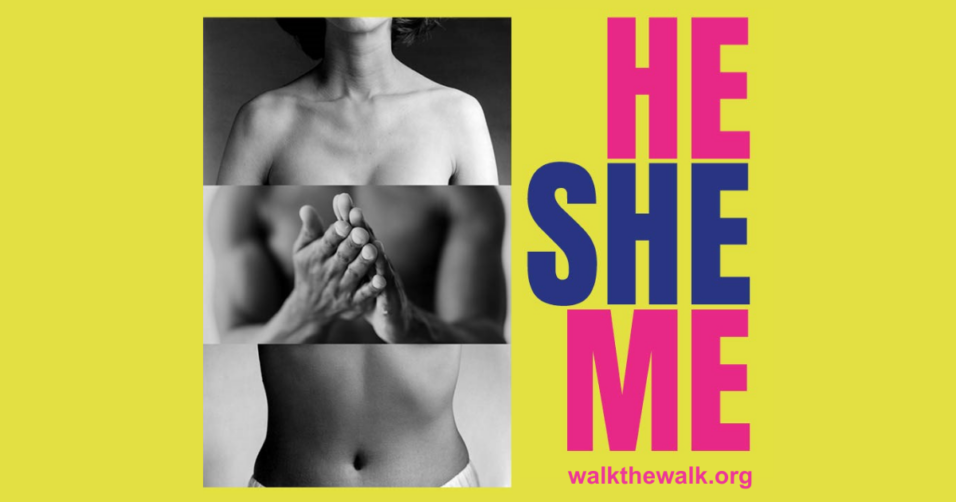For He, She, or You 8 common signs to check for breast cancer!
- Are your breasts or chest area symmetrical or has one side become slightly lower than the other?
- Are there any unusual changes in the shape or size of one of your breasts
- Look for changes in skin colour or a rash around the nipple.
- A nipple that has become pulled in or changed its position or shape (retraction of the nipples is normal in some women).
- Puckering or dimpling of the skin.
- A lump or thickening within the breast or armpit.
- Discharge from one nipple or both.
- Constant pain in one part of the breast.
The earlier breast cancer is detected, the greater the chance of successful treatment and cure. Remember 9 out of 10 breast lumps are not cancerous!
When and how to check your breasts
Make a diary date to check your chest or breasts on the same day each month. Or, if you have them, 2 – 3 days after your period. Whether you check by standing in front of a mirror, lying down or checking whilst showering using a wet soapy hand… Choose whichever way is the most comfortable and easiest for you!
Using a full length mirror – With a straight back, place your hands on your hips, looking at your reflection check for any colour changes such as redness, changes to the skin texture such as dimpling, puckering or a skin rash and any visible changes to the nipple such as a discharge.
Raise both your arms above your head – and check again for the same changes, as well as any visible lumps in the armpit, or any unusual pains or discomfort.
Lying down – Allows you to feel deep breast tissue more easily, especially if you use body oil to allow your hand to glide. Take your right hand keeping your fingers close together, begin by moving the pads of your fingers in a small circular motion around your breast or chest area. Start at the nipple and move outwards in circles up to the collarbone, including your armpit area. Then swap hands and repeat on your other side.
In the shower – Again apply soap to your hand so your fingertips can glide over the skin and following the same check as for lying down use small circular movements, working outwards from the nipple, up to the collar bone, down to the ribs and under the arm.
Print a poster and stick it up wherever you can, at work, in your local gym, hairdresser, pub, or anywhere else you think it will make a difference… help us spread the word!

One for the boys… #MenGetBreastCancerToo!
- Men don’t think of themselves as having breasts, but they do!
- Did you know that 370 – 400 men a year in the UK are diagnosed with breast cancer?
- It usually affects men aged 50 and over, but it can be found in men of any age.
- The diagnosis of breast cancer in men, as well as the treatment, is very similar to that for women. However, over 80 men a year die from breast cancer due to not knowing men can get this type of cancer, and not performing regular checks.
- A man can have an increased risk of breast cancer, if a number of close female relatives have been affected by breast cancer, particularly at a young age. Men can inherit the BRCA1 and BRCA2 genes, which also cause breast cancer in women.
- Many men are diagnosed with breast cancer relatively late because they didn’t realise breast cancer could affect them too.
- Check out our #MenGetBreastCancerToo page here
One for the girls…
- 1 in 7 women in the UK will experience some form of breast cancer during their lifetime. This amounts to over 55,000 women a year, and 1 woman every 10 minutes will be diagnosed and receive a breast cancer diagnosis.
- 27% of breast cancers in women are now thought to be avoidable by changes to lifestyle and 7% of those just by being more active
- Whilst more women are being successfully treated and surviving primary breast cancer, in fact with early diagnosis it is almost a treatable disease. Those with Secondary cancers do not yet have the same choices of survival. Research is continually developing and we hope in the not too distant future those choices will be available.
- Being active can make a big difference… Women who are physically active have a 13% reduced risk of postmenopausal breast cancer and a 7% decreased risk of premenopausal breast cancer compared to women who are less active.
Did you know?
- Around 40% of all cancers could be preventable, this equates to nearly 155,000 cases in the UK a year.
- Eating a healthier diet by reducing highly processed foods, being more active each day and maintaining a healthy weight are – after not smoking – the most important ways you can reduce your cancer risk.
- World Cancer Research Fund recommends that to help prevent cancer, we should all make being physically active part of our everyday lives.
- In 2017 due to there being little to no help or resources available for men, Walk the Walk started the Campaign ‘Men Get Breast Cancer Too’ as a result we pulled together a collaboration of charities, managed to raise awareness in the media and helped the men to form a group. 6 years later and it’s a different story, men are getting support and we feel incredibly proud to have played our part!
- Amongst other support for men, a grant from Walk the Walk helped fund Breast Cancer Now’s ‘Male Breast Cancer Study’, which has the largest collection of DNA and tumour samples from men with breast cancer in the world. Scientists are looking into both the genetic causes and treatments for male breast cancer.

